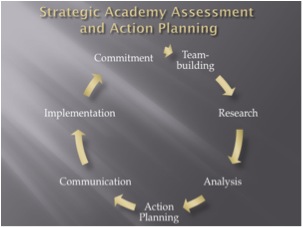Article XX: Strategic Academy Assessment and Action Planning
Every academy should formalize a process for continuous qualitative and quantitative growth. It seems a healthy organization needs a well-entrenched culture of improvement that becomes a normal habit. The Headmaster as CEO will lead this process, sometimes with the aid of a consultant that has developed multiple academies. He will add effervescence for a good academy to become great and for the newly developing academy to achieve sustainability. We recommend use of the seven categories of AdvancEd Standards for Accreditation and Quality Standards with additions for analysis of branding, external and competitive factors, and school statistics. Then use a form of SWOT analysis (strengths, weaknesses, opportunities and threats) as the basis for the Strategic Academy Assessment. After the analysis is complete, the intention is to provide a comprehensive action plan for the qualitative and quantitative improvement of the school. The headmaster or consultant will coach the process from beginning to end. Through these means the academy will improve and prepare for accreditation.
TABLE OF CONTENTS
Each category in the table of contents is fully developed in the assessment and action planning template
Summary of Steps toward Success – See below
STANDARD 1: VISION AND PURPOSE
STANDARD 2: GOVERNANCE AND LEADERSHIP
STANDARD 3: TEACHING AND LEARNING
STANDARD 4: DOCUMENTING AND USING RESULTS
STANDARD 5: RESOURCES AND SUPPORT SYSTEMS
STANDARD 6: STAKEHOLDER COMMUNICATION AND RELATIONSHIPS
STANDARD 7: COMMITMENT TO CONTINUOUS IMPROVEMENT
SECTION 8: EXTERNAL FACTORS, BRANDING, IDENTITY AND GROWTH
SECTION 9: SCHOOL STATISTICS
SECTION 10: HEADMASTER AND TEAM CHAIR ANALYSIS AND PLAN
SECTION 11: BOARD ANALYSIS AND PLAN
SECTION 12: CONCLUDING THOUGHTS AND REPORT TO CONSTITUENTS
Summary of Steps toward Success
1. Executive Summary prior to assessment process.
a. Summarize the primary challenge the school is facing; the problem it needs to solve, or the desire it longs to fulfill.
b. Summarize the expected outcome of the analysis; if you had to decide what to do right now, before the SAA what would you recommend.
c. School Objectives for the next 3 – 5 years as you seem them now, prior to the process.
2. Teambuilding and Preparation
a. Win all school constituencies necessary to the process of the Strategic Academy Assessment so that all work toward the qualitative and quantitative improvement of the school. Constituencies consist of the board, headmaster, division or department heads, faculty, staff, donors, parents, students, alumni, and a few people from the community with a high interest in the success of the school.
b. Choose three to nine small teams of two to three qualified people to address each of the categories. Determine a chair for each team. The Headmaster is either the chair of each team, a member of each team or an ex-officio member of each team. If you prefer a simpler alternative choose a smaller team.
c. Meet with the teams to explain the process, determine a timeline, and work out the practical means for its accomplishment. When, how often and where will teams meet and what is the first deadline.
d. Each team uses the Strategic Academy Assessment Template section or sections for which they are responsible as a guide to their research and analysis.
e. Carefully survey constituencies remembering that if in the survey someone says they want something they will expect you to do it. The consultant can recommend questions.
f. The headmaster should meet weekly with the team chairs to spur progress.
3. Analysis with SWOT and Action Planning
a. When Executive Summaries are completed the Headmaster or consultant may make preliminary recommendations to handle urgent items and give further direction to the process.
b. When each team has completed its portion of the template including a recommended action plan, the headmaster with team chairs perform the last step of SWOT analysis; recommend a prioritized comprehensive action plan with a timeline for implementation.
c. Submit the plan to the Board.
d. The board should seriously consider the report and its conclusions and then perform its own SWOT analysis, recommend a prioritized comprehensive action plan with a timeline for implementation.
e. Since strategic planning of any kind must also include strategic financial planning, the board and headmaster will also need to determine the budgetary considerations of each action plan item and provide the funding for achievement by the determined deadline.
4. Coaching, Critique and Recommendations by a Qualified Outside Consultant
a. The headmaster or consultant coaches the process from beginning to end.
b. When Executive Summaries are completed the outside consultant may make preliminary recommendations to handle urgent items and give further direction to the process.
c. When the initial team reports are submitted to the headmaster, then the consultant meets with all teams during a campus site visit.
d. An interim report and short-term recommendations may be made following the site visit.
e. After the headmaster and board complete SWOT analysis and Action plans, the outside consultant conducts his/her analysis and presents results during a working session with the headmaster and board
5. Presentation to All Constituencies
a. Provide public oral presentation of conclusions with illustrations while allowing Q&A.
b. Back up the public presentation with a written report and illustrations.
The idea is to make continuous qualitative and quantitative improvement a part of the academy culture. This is not a process that is completed and filed away, but rather, completed implemented and started again as part of a healthy planning cycle.
Upcoming Articles on The Headmaster as CEO Begin Soon:
When Chicken Little Cries, “The Sky is Falling!”
The Headmaster as Chief Financial Officer
Leadership Agility
And many more

